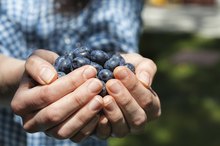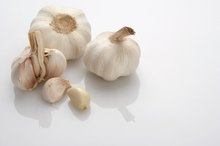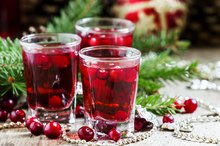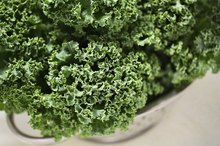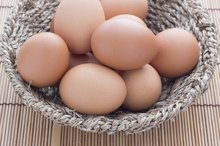Can Certain Fruits and Vegetables Reduce Blood Clots?
Blood clots are clumps of blood that form in the blood vessels and can travel into the heart, lungs and brain. Blood clots can cause conditions such as strokes, angina, arterial embolisms, deep vein thrombosis, heart attacks, pulmonary embolisms and renal vein thrombosis. If you have suffered from any of these conditions or are at risk, your physician may prescribe blood thinners, or anticoagulants like Coumadin, in order to reduce your risk for blood clots. Many physicians will also prescribe an aspirin a day in order to reduce the risk of blood clotting. In addition to these medications, there are also natural fruits and vegetables that can help reduce the risk of blood clots.
Foods High in Salicylates
You may have heard of physicians prescribing an aspirin a day to reduce the risk of blood clotting. According to the National Institutes of Health, the components in aspirin that are responsible for reducing blood clotting risk are called salicylates. Salicylates can also be found in a wide variety of fruits and vegetables. According to the Auckland Allergy Clinic, the following fruits and vegetables are very high in salicylate content: apricots, oranges, blackberries, pineapple, blackcurrant, plums, blueberries, prunes, raisins, raspberries, strawberries, grapes, cranberries, tangerines, hot peppers, olives, radishes, tomatoes and chicory.
- You may have heard of physicians prescribing an aspirin a day to reduce the risk of blood clotting.
- According to the National Institutes of Health, the components in aspirin that are responsible for reducing blood clotting risk are called salicylates.
Foods High in Omega-3 Fatty Acids
Can You Eat Certain Foods to Lighten Thick Blood?
Learn More
According to the Harvard School of Public Health, omega-3 fatty acids are essential nutrients that aid in the regulation of normal blood clotting. Most people believe that in order to receive omega-3 fatty acids, they must consume a high a diet that is high in fish. While fish is a good source of omega-3 fatty acids, they can also be found in many vegetables including Brussels sprouts, kale, spinach and salad greens.
Foods High in Vitamin E
A 2011 study published in the journal “Thrombosis Research” examined the effects of vitamin E on blood clot formation. What researchers discovered is that vitamin E is capable of inhibiting platelets, the cells responsible for clotting, from forming clots and in that way works as a natural anticoagulant. According to the Office of Dietary Supplements, vitamin E can be found in a variety of oils, as well as spinach, broccoli, kiwifruit, mangos and tomatoes.
Considerations
Should I Eat Kiwi Fruit If I Take Blood Thinners?
Learn More
While fruits and vegetables are a part of a balanced diet, adding too many fruits and vegetables that have natural blood thinning properties can cause complications. If you are being treated with anticoagulants such as Coumadin, you will need to limit your intake of these fruits and vegetables, as they can increase your risk of bruising and bleeding. Tell your physician about all the medications you take and your regular diet, as he may adjust your medication or advise you on your dietary intake.
Related Articles
References
- MedlinePlus: Blood Clots
- MedlinePlus: Blood Thinners
- MedlinePlus: Aspirin
- Auckland Allergy Clinic: Salicylate Sensitivity
- Thrombosis Research: Vitamin E Inhibition on Platelet Procoagulant Activity: Involvement of Aminophospholipid Translocase Activity
- National Institutes of Health: Office of Dietary Supplements: Vitamin E
- Andrade AR, Barros LL, Azevedo MFC, et al. Risk of thrombosis and mortality in inflammatory bowel disease. Clin Transl Gastroenterol. 2018;9(4):142. doi:10.1038/s41424-018-0013-8
- Faye AS, Wen T, Ananthakrishnan AN, et al. Acute venous thromboembolism risk highest within 60 days after discharge from the hospital in patients with inflammatory bowel diseases. Clin Gastroenterol Hepatol. 2019. doi:10.1016/j.cgh.2019.07.028
- American Society of Hemotology. Blood clots.
- Centers for Disease Control and Prevention. Data and statistics on venous thrombolism. Updated March 14, 2019.
- American Heart Association. Understanding your risk for excessive blood clotting.
- Kappelman MD, Horvath-puho E, Sandler RS, et al. Thromboembolic risk among Danish children and adults with inflammatory bowel diseases: a population-based nationwide study. Gut. 2011;60(7):937-943. doi:10.1136/gut.2010.228585
- Grainge MJ, West J, Card TR. Venous thromboembolism during active disease and remission in inflammatory bowel disease: a cohort study. Lancet. 2010;375(9715):657-663. doi;10.1016/S0140-6736(09)61963-2
- Nguyen GC, Bernstein CN, Bitton A, et al. Consensus statements on the risk, prevention, and treatment of venous thromboembolism in inflammatory bowel disease: Canadian Association of Gastroenterology. Gastroenterology. 2014;146(3):835-848.e6. doi:10.1053/j.gastro.2014.01.042
- Papa A, Gerardi V, Marzo M, Felice C, Rapaccini GL, Gasbarrini A. Venous thromboembolism in patients with inflammatory bowel disease: focus on prevention and treatment. World J Gastroenterol. 2014;20(12):3173-3179. doi:10.3748/wjg.v20.i12.3173
- Division of Blood Disorders National Center on Birth Defects and Developmental Disabilities, Centers for Disease Control and Prevention "Venous Thromboembolism (Blood Clots): Data & Statistics.” CDC.gov. 6 Apr 2017.
Writer Bio
Deborah Lundin is a professional writer with more than 20 years of experience in the medical field and as a small business owner. She studied medical science and sociology at Northern Illinois University. Her passions and interests include fitness, health, healthy eating, children and pets.
